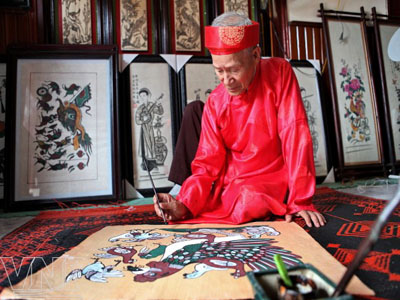A “living treasure” in Dong Ho panting village
VGP – Old artisan Nguyen Huu Sam in the village, which specializes in making Dong Ho folk paintings in Dong Ho Village, Song Ho Commune, Thuan Thanh District, Bac Ninh Province is considered a “living treasure” of the village.
|
|
|
At the age of over 80, old artisan Nguyen Huu Sam still devotes himself to drawing paintings - Photo: VNP |
He has been engaged in this craft since he was three years old. Now, at the age of over 80 he is bequeathing the craft to his descendents with a desire to preserve this ancient craft.
In the old days Dong Ho Village had the name Mai Village, also locally known as Dong Ho painting village. Situated on the bank of the Duong River, the village was famous for the craft of making Dong ho paintings.
In March 2013, the craft of making Dong Ho folk paintings was recognized as a National Intangible cultural Heritage. Recently, the PM approved the preparation of a dossier to submit to UNESCO for its recognition of the making of Dong Ho folk paintings as an Intangible Cultural Heritage that needs urgent protection in the 2011-2016 period.
Recently, we made a trip to visit Dong Ho Village with a desire to meet old artisan Nguyen Huu Sam. Just when we arrived at the dyke in the village and talked with the villagers about the artisan, they intimately told us about him.
The old house owned by the artisan is situated in a long alley of the village. On the walls of the house there are many folk paintings in different genres, from daily life paintings to landscape paintings shown in a set of “four times” and “four seasons”. Nguyen Huu Sam told us about his part. When he was three years old, he was instructed in the craft of making Dong Ho paintings by his father. At five, he could help his father apply the seashell powder paint to the Do paper and learn how to print the paper with proper colors. At seven, he was able to draw with a pen and make the most difficult samples of the Dong Ho paintings. Years went by and the soul of Dong Ho folk paintings has kept him busy devoting his life to this career.
Sam said that 17 clans in the village have been engaged in making Dong Ho paintings. In the 1940s this craft flourished. Even in the 1945 New Year Festival, while a famine was spreading out, leaving over two million people dead, the market selling the paintings in Dong Ho Village was still open. At that time Nguyen Huu Sam was assigned by his parents to make the paintings to the market for sale. Unexpectedly, it was the last day of the painting market in the village that he witnessed.
Artisan Nguyen Huu Sam has always been devoted to the making of Dong Ho paintings and has waited for opportunities to restore this traditional craft. In 1967, when the local authorities assigned him to restore the traditional genre of Dong Ho folk paintings, he gathered 50 villagers with professional skills and collected hundred of woodblocks to establish the Dong Ho Painting Cooperative. Thanks to his efforts, such famous paintings at “Rat’s wedding”, “Rooster”, “Scene of jealousy” and “Writing verses about precious flowers” have been revived. Dong Ho paintings have been available in many parts of the world such as Japan, France, Germany, Singapore and the United States. In 1990, due to the change of the economic situation, Dong Ho paintings were difficult to sell and the cooperative was dissolved. Many craftsmen quit their job. Feeling sad with this situation, artisan Nguyen Huu Sam went to each family to buy the woodblocks for printing Dong Ho paintings because he said that these woodblocks were very important and served as the soul of the traditional craft. So far, he has preserved over 600 valuable ancient woodblocks. Also, he has created new woodblocks which are very unique and suitable to the aesthetic tastes of people today.
Now, the production of Dong ho paintings is not as prosperous as in the past. Many families in the village have quit doing this craft, but Nguyen Huu Sam’s family is still preserving it by continuing to make the paintings with the traditional folk themes and creating the new samples to meet the market demands.
Under his guidance, his two sons have also been determined to succeed him in making Dong Ho paintings. Thanks to his meticulous teaching, his grandchildren have become skilled craftsmen.
Nguyen Huu Qua, the second son of artisan Nguyen Huu Sam currently owns a painting workshop in the village. His house has become a fascinating cultural destination for tourists, especially foreign tourists who come to contemplate and buy the paintings.
For Sam, making the paintings is a career because it sustains the life of many generations of the family. So he always thinks of the survival of this traditional craft and is determined to preserve it. He has tried his utmost to bequeath the secrets of the craft to his descendants, with a thought that the craft of the village is also the craft of the family and the descendents of the family must know and preserve the traditional craft at all costs.
Nguyen Thi Oanh, a daughter in law of artisan Nguyen Huu Sam said that her father loved the craft very much and he had made great efforts to establish his business. He told his children and grandchildren to preserve the traditional craft to help conserve a precious painting genre of the village.
Now at the age of over 80 he is still healthy with keen eyes and skillful hands in drawing. His house is always full of shining colors of the folk paintings, showing the sustainable existence of a rare folk painting genre in Viet Nam.
Viet Nam Pictorial

